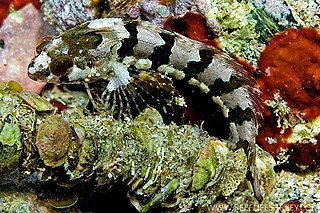
The longnose catshark is a species of shark belonging to the family Pentanchidae, the deepwater catsharks. This shark is found in the eastern central Pacific from central and southern California and the Gulf of California, between latitudes 38° N and 23° N, at depths down to 1,890. Its length is up to 58 cm.

The giant Atlas barbel was a ray-finned fish species in the family Cyprinidae. It is now thought to be extinct.
George Sprague Myers was an American ichthyologist who spent most of his career at Stanford University. He served as the editor of Stanford Ichthyological Bulletin as well as president of the American Society of Ichthyologists and Herpetologists. Myers was also head of the Division of Fishes at the United States National Museum, and held a position as an ichthyologist for the United States Fish and Wildlife Service. He was also an advisor in fisheries and ichthyology to the Brazilian Government.
Haplochromis bartoni was a species of cichlid endemic to Lake Victoria. This species can reach a length of 19.5 centimetres (7.7 in) SL. It has not been recorded in recent surveys but as the whole of Lake Victoria has not ben surveyed for this species the IUCN classify it as Data Deficient. This species was said by Greenwood to bear some resemblance to Haplochromis worthingtoni so he named this species after E. Barton Worthington (1905-2001) as well.

Haplochromis bayoni is a species of cichlid endemic to Lake Victoria. This species reaches a length of 15.4 centimetres (6.1 in) SL. The specific name honours the Italian British physician and researcher into sleeping sickness Henry Peter Bayon (1876-1952).
Haplochromis michaeli is a species of cichlid endemic to Lake Victoria. It is critically endangered, thought it may now be extinct. This species can reach a length of 14.5 centimetres (5.7 in) SL. The specific name honours the collector of the type, the British fisheries scientist Michael Graham (1888-1972).

Haplochromis sauvagei is a species of cichlid endemic to Lake Victoria. This species reaches a length of 10.5 centimetres (4.1 in) SL. Its specific name honours the French paleontologist and ichthyologist Henri Émile Sauvage (1842-1917).
Maurice Kottelat is a Swiss ichthyologist specializing in Eurasian freshwater fishes.
Microsynodontis lamberti is a species of upside-down catfish endemic to the Democratic Republic of the Congo where it is found in the Lilanda River. This species grows to a length of 3.5 centimetres (1.4 in) SL.

Labeo bottegi is fish in genus Labeo. It is known from Ethiopia, Kenya, and Somalia.
Enteromius stanleyi is a species of ray-finned fish in the genus Enteromius which is endemic to the Congo River system in the Democratic Republic of the Congo.

Osteobrama belangeri is a species of ray-finned fish in the genus Osteobrama. It was found in the Indian state of Manipur, but has been extirpated there and as of 2022 is found in the wild only in Myanmar. Farmed populations in Manipur and wild-caught fish from in Myanmar are used as food. The extirpation from Manipur was caused by dam building, habitat degradation and the introduction of alien species which caused the populations to fragment.

Hypsoblennius gilberti, commonly known as the rockpool blenny, is a species of combtooth blenny found in the eastern Pacific Ocean. This species grows to a length of 17 centimetres (6.7 in) TL. The specific name honours the American ichthyologist Charles H. Gilbert (1859–1928).

Heteroclinus whiteleggii, Whitelegg's weedfish, is a species of clinid native to reefs around New South Wales, Australia. This species can reach a maximum length of 10 centimetres (3.9 in) TL. The specific name honours the naturalist Thomas Whitelegge (1850-1927) who was a friend of Ogilby's friend and who collected the type.
Axoclinus rubinoffi, known commonly as Rubinoff's triplefin, is a species of triplefin blenny. This species is endemic to Malpelo Island in the eastern Pacific off Colombia. The specific name of this fish honours the American marine biologist Ira Rubinoff, Director of the Smithsonian Tropical Research Institute.

Mugil thoburni, Thoburn's mullet, is a species of grey mullet, from the family Mugilidae, found in the eastern Pacific Ocean. It is most common around the Galapagos Islands but does occur on the coasts of Central America and South America as well. This species grows to a length of 29.5 centimetres (11.6 in) TL. It was formerly regarded as the only known member of the genus Xenomugil.
The Guinea flathead is a species of marine ray-finned fish belonging to the family Platycephalidae, the flatheads. It is found in the eastern Atlantic Ocean along the western coast of Africa. This species is the only known member of the genus Solitas. It is also the only flathead species which has a natural distribution which lies outside of the Indo-Pacific.
Gerald Robert "Gerry" Allen is an American-born Australian ichthyologist. His career began in 1963, when he spent a semester at the University of Hawaii, where he also received a PhD in marine zoology in 1971. In 1972, Allen wrote his doctoral thesis on the systematics and biology of the anemone fish.
Cable's goby is a species of goby endemic to reefs around the Galápagos Islands. This species grows to a length of 7 centimetres (2.8 in) SL. This species is the only known member of its genus. The specific name honours the United States Government biologist Louella E. Cable (1900-1986), who illustrated this goby for the describer Isaac Ginsburg, and drew his attention to its separated ventral fins.

Jean Abel Gruvel was a French marine biologist known for his research of cirripedes.










